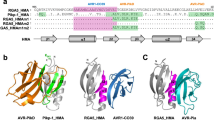Abstract
Immunomodulation involves the use of antibodies to alter the function of molecules and is an emerging tool for manipulating both plant and animal systems. To realize the full potential of this technology, two major obstacles must be overcome. First, most antibodies do not function well intracellularly because critical disulfide bonds cannot form in the reducing environment of the cytoplasm or because of difficulties in targeting to subcellular organelles. Second, few antibodies bind to the active sites of enzymes and thus they generally do not neutralize enzyme function. Here we show that the unique properties of single-domain antibodies from camelids (camels and llamas) can circumvent both these obstacles. We demonstrate that these antibodies can be correctly targeted to subcellular organelles and inhibit enzyme function in plants more efficiently than antisense approaches. The use of these single-domain antibody fragments may greatly facilitate the successful immunomodulation of metabolic pathways in many organisms.
This is a preview of subscription content, access via your institution
Access options
Subscribe to this journal
Receive 12 print issues and online access
$209.00 per year
only $17.42 per issue
Buy this article
- Purchase on Springer Link
- Instant access to full article PDF
Prices may be subject to local taxes which are calculated during checkout





Similar content being viewed by others
References
De Jaeger, G., De Wilde, C., Eeckhout, D., Fiers, E. & Depicker, A. The plantibody approach: expression of antibody genes in plants to modulate plant metabolism or to obtain pathogen resistance. Plant Mol. Biol. 43, 419–428 (2000).
Conrad, U. & Manteuffel, R. Immunomodulation of phytohormones and functional proteins in plant cells. Trends Plant Sci. 6, 399–402 (2001).
Hiatt, A., Cafferkey, R. & Bowdish, K. Production of antibodies in transgenic plants. Nature 342, 76–78 (1989).
Hamers-Casterman, C. et al. Naturally occurring antibodies devoid of light chains. Nature 363, 446–448 (1993).
Muyldermans, S. Cambillau, C. & Wyns, L. Recognition of antigens by single-domain antibody fragments: the superfluous luxury of paired domains. Trends Biochem. Sci. 26, 230–235 (2001).
Frenken, L.G.J. et al. Isolation of antigen specific llama VHH antibody fragments and their high level secretion by Saccharomyces cerevisiae. J. Biotechnol. 78, 11–21 (2000).
Van der Linden, R.H.J. et al. Improved production and function of llama heavy chain antibody fragments by molecular evolution. J. Biotechnol. 80, 261–270 (2000).
Lauwereys, M. et al. Potent enzyme inhibitors derived from dromedary heavy-chain antibodies. EMBO J. 17, 3512–3120 (1998).
Jobling, S.A. et al. A minor form of starch branching enzyme in potato (Solanum tuberosum L.) tubers has a major effect on starch structure: cloning and characterisation of multiple forms of SBE A. Plant J. 18, 163–171 (1999).
Schwall, G.P. et al. Production of very-high amylose potato starch by inhibition of SBE A and B. Nat. Biotechnol. 18, 551–554 (2000).
Kortsee, A.J. et al. Expression of Escherichia coli branching enzyme in tubers of amylose-free potato leads to an increased branching degree of the amylopectin. Plant J. 10, 83–90 (1996).
Safford, R. et al. Consequences of antisense RNA inhibition of starch branching enzyme activity on properties of potato starch. Carbohyd. Polym. 35, 155–168 (1998).
Hovenkamp-Hermelink, J.H.M. et al. Rapid estimation of the amylose/amylopectin ratio in small amounts of tuber and leaf tissue of the potato. Potato Res. 31, 241–246 (1988).
Morrison, W.R. and Laignelet, B. An improved colourimetric procedure for determining apparent total amylose in cereal and other starches. J. Cereal Sci. 1, 9–20 (1983).
Lecerf, J.-M. et al. Human single-chain Fv intrabodies counteract in situ huntingtin aggregation in cellular models of Huntington's disease. Proc. Natl. Acad. Sci. USA 98, 4764–4769 (2001).
Lasowski, R.A., Luscombe, N.M., Swindells, M.B. & Thornton, J.M. Protein clefts in molecular recognition and function. Protein Sci. 5, 2438–2452 (1996).
Wörn, A et al. Correlation between in vitro stability and in vivo performance of anti-GCN4 intrabodies as cytoplasmic inhibitors. J. Biol. Chem. 275, 2795–2803 (2000).
Auf der Maur, A. Escher, D. & Barberis, A. Antigen-independent selection of stable intracellular single-chain antibodies. FEBS Lett. 508, 407–412 (2001).
Visintin, M. et al. The intracellular antibody capture technology (IACT): towards a consensus sequence for intracellular antibodies J. Mol. Biol. 317, 73–83 (2002).
Harmsen, M.M et al. Llama heavy-chain V regions consist of at least four distinct subfamilies revealing novel sequence features. Mol. Immunol. 37, 579–590 (2000).
Harrison, J.L., Williams, S.C., Winter, G. & Nissim, A. Screening of phage antibody libraries. Meth. Enzymol. 267, 83–109 (1996).
Hull, R., Sadler, J. & Longstaff, M. The sequence of carnation etched ring virus-DNA—comparison with cauliflower mosaic-virus and retroviruses. EMBO J. 5, 3083–3090 (1986).
Becker, D., Kemper, E., Schell, J. & Masterson, R. New plant binary vectors with selectable markers located proximal to the left T-DNA border. Plant Mol. Biol. 20, 1195–1197 (1992).
Acknowledgements
The authors wish to thank Paul van der Logt and colleagues for preparation of the llama “one pot” antibody library, and Tina Sanders, Alice Belton and Bob Cowper for the generation and maintenance of the potato plants. Special thanks go to Tony Lee and Theo Verrips for their unwavering support for this project.
Author information
Authors and Affiliations
Corresponding author
Ethics declarations
Competing interests
The authors declare no competing financial interests.
Rights and permissions
About this article
Cite this article
Jobling, S., Jarman, C., Teh, MM. et al. Immunomodulation of enzyme function in plants by single-domain antibody fragments. Nat Biotechnol 21, 77–80 (2003). https://doi.org/10.1038/nbt772
Received:
Accepted:
Published:
Issue Date:
DOI: https://doi.org/10.1038/nbt772
This article is cited by
-
Suppressed expression of starch branching enzyme 1 and 2 increases resistant starch and amylose content and modifies amylopectin structure in cassava
Plant Molecular Biology (2022)
-
A comprehensive comparison between camelid nanobodies and single chain variable fragments
Biomarker Research (2021)
-
Applications of nanobodies in plant science and biotechnology
Plant Molecular Biology (2021)
-
A novel epitope tagging system to visualize and monitor antigens in live cells with chromobodies
Scientific Reports (2020)
-
Seed-produced anti-globulin VHH-Fc antibodies retrieve globulin precursors in the insoluble fraction and modulate the Arabidopsis thaliana seed subcellular morphology
Plant Molecular Biology (2020)



